May 20th Scots Book of Days Eliza Doolittle Day
May 20 – Eliza Doolittle Day in My Fair Lady (film), released 1964, starring Audrey Hepburn. Hepburn’s father, Joseph Victor Anthony Ruston (1889–1980), was British born, changed the surname to the more “aristocratic” Hepburn-Ruston, believing himself descended from James Hepburn, Earl Bothwell, (clan Hepburn) third husband of Mary, Queen of Scots, star crossed lovers.
685 Battle of Dunnichen. King Bridei Mac Bili defeats the Northhumbrians. Ending Northumbrian hegemony in northern Britain. www.bbc.co.uk
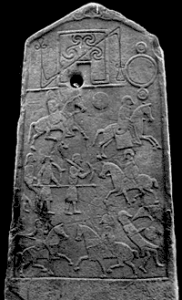 Aberlemno Sculptured Stone Number II – are carved symbols stones of the Picts. The Battle Stone in Aberlemno churchyard, 4 miles north of Dunnichen, in Angus, depict the events of the nearby Battle of Dunnichen fought against the Angles of Northumbria in 685 AD. Four scenes – a Pictish warrior, so skilled in horsemanship he doesn’t require to hold onto the horse’s reins, chases away an Angle who has clearly thrown away his sword and shield in the panic of his flight. Below that, a group of three Pictish warriors on foot confront an Angle horseman armed with a spear.
Aberlemno Sculptured Stone Number II – are carved symbols stones of the Picts. The Battle Stone in Aberlemno churchyard, 4 miles north of Dunnichen, in Angus, depict the events of the nearby Battle of Dunnichen fought against the Angles of Northumbria in 685 AD. Four scenes – a Pictish warrior, so skilled in horsemanship he doesn’t require to hold onto the horse’s reins, chases away an Angle who has clearly thrown away his sword and shield in the panic of his flight. Below that, a group of three Pictish warriors on foot confront an Angle horseman armed with a spear.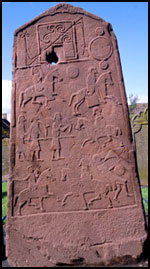 The three Picts are armed with swords, spears and shields. Some historians believe that this may show how the Picts actually fought in battle. The front rank wielded sword and shield, covered by the second rank with their spears lowered to protect the swordsmen and ward off mounted warriors. Behind that the third rank of the Pictish battle line would stand in reserve. Below these three Picts, two mounted warriors do battle. Some historians have speculated that the Angle rider may be the Northumbrian King Ecgfrith. If this is the case, then perhaps the Pictish rider could be King Bridei – kind of like a Bayeux Tapestry in stone. [The Angles, having over run the south of Britain, will change the name of the southern island to Angle-Terre – still so called in Francais – or Angle Land for Anglish or Inglysh or English!)
The three Picts are armed with swords, spears and shields. Some historians believe that this may show how the Picts actually fought in battle. The front rank wielded sword and shield, covered by the second rank with their spears lowered to protect the swordsmen and ward off mounted warriors. Behind that the third rank of the Pictish battle line would stand in reserve. Below these three Picts, two mounted warriors do battle. Some historians have speculated that the Angle rider may be the Northumbrian King Ecgfrith. If this is the case, then perhaps the Pictish rider could be King Bridei – kind of like a Bayeux Tapestry in stone. [The Angles, having over run the south of Britain, will change the name of the southern island to Angle-Terre – still so called in Francais – or Angle Land for Anglish or Inglysh or English!)
If ye dinnae ken Dunnichen ye’re nae worth kennin’. [‘If ye don’t know Dunnichen, you’re not worth knowing.” ‘If ye don’t understand Dunnichen, you’re not worthy to understand.’] Arguably the most important turning point in Scottish history“. James E. Fraser, historian. For on this day in 685 AD the sapling of a country set to become Scotland faced being trampled under a Saxon boot. www.myspace.com/kingbridei/blog
Headrick in the Second Statistical Account, claimed that the site was the location of the Battle of Camlann, where King Arthur fought Mordred. A confused tradition prevails of a great battle having been fought on the East Mains of Dunnichen, between Lothus, King of the Picts, or his son Modred, and Arthur King of the Britons, in which that hero of romance was slain. Buchanan, no doubt, places the scene of that battle upon the banks of the Humber, in England. But it is probable that some battle had been fought here[…]
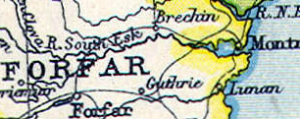 In 1810, antiquarian George Chalmers identified that site as the probable location of the Battle of Dun Nechtain in 20 May 685. See the line, which is the road, between the towns of Forfar and Brechin? About halfway is the village of Aberlemno (about where the letter ‘h’ is located in South Esk. So the Angles may have been invading inland from East to West along the River Esk.
In 1810, antiquarian George Chalmers identified that site as the probable location of the Battle of Dun Nechtain in 20 May 685. See the line, which is the road, between the towns of Forfar and Brechin? About halfway is the village of Aberlemno (about where the letter ‘h’ is located in South Esk. So the Angles may have been invading inland from East to West along the River Esk.
Aberlemno (Gaelic: Obar Leamhnach) is a parish and small village in the Scottish council area of Angus. Three large carved Pictish stones (and one fragment) dating from the 7th and 8th centuries AD (Historic Scotland); the stones can be viewed at any time in spring-autumn, but are covered by wooden boxes in the winter to prevent frost damage.
The Picts victorious at the Battle of Dunnichen – 685 AD. An Angle invasion of Pictland leads to all-out war. The two armies meet at a site believed to be Dunachton, Badenoch. After savage fighting, the Picts destroy the Angle army. Video: A history of Scotland: The Last of the Free.
http://www.bbc.co.uk/scotland/history/early_scotland/the_picts_victorious_at_the_battle_of_dunichen/
804 Alcuin of York, Deacon, Abbot of Tours, 804 Alcuin died on 19 May 804, some ten years before the emperor Charles, and was buried at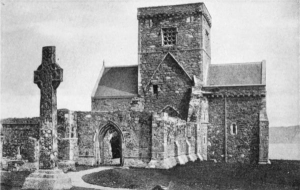 St. Martin’s Church. CATHEDRAL OF IONA AND ST. MARTIN’S CROSS. The Spell of Scotland by Keith Clark, 1916 to the Lord Marischall, Boston The Page Company. P.274. Isle of Iona
St. Martin’s Church. CATHEDRAL OF IONA AND ST. MARTIN’S CROSS. The Spell of Scotland by Keith Clark, 1916 to the Lord Marischall, Boston The Page Company. P.274. Isle of Iona
1215 English barons organized against King John. King John descends from Malcolm 3rd, King of Scots. Demands. Barons gather away from London. Drafted by Stephen, the Archbishop of Canterbury to make peace. 25 barons will guarantee the provisions.
‘KNOW THAT BEFORE GOD, for the health of our soul and those of our ancestors and heirs, to the honour of God, the exaltation of the holy Church, and the better ordering of our kingdom, at the advice of our reverend fathers Stephen, archbishop of Canterbury, primate of all England, and cardinal of the holy Roman Church, Henry archbishop of Dublin, William bishop of London, Peter bishop of Winchester, Jocelin bishop of Bath and Glastonbury, Hugh bishop of Lincoln, Walter bishop of Worcester, William bishop of Coventry, Benedict bishop of Rochester, Master Pandulf subdeacon and member of the papal household, Brother Aymeric master of the knighthood of the Temple in England, William Marshal earl of Pembroke, William earl of Salisbury, William earl of Warren, William earl of Arundel, Alan of Galloway constable of Scotland, Warin fitz Gerald, Peter fitz Herbert, Hubert de Burgh seneschal of Poitou, Hugh de Neville, Matthew fitz Herbert, Thomas Basset, Alan Basset, Philip Daubeny,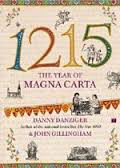 Robert de Roppeley, John Marshal, John fitz Hugh, and other loyal subjects:’ – See more at: http://www.bl.uk/magna-carta/articles/ magna-carta-english-translation#sthash.XnU3cAFI.dpuf In 85 years, a descendant of the earl of Warren will be the Protector of Scotland.
Robert de Roppeley, John Marshal, John fitz Hugh, and other loyal subjects:’ – See more at: http://www.bl.uk/magna-carta/articles/ magna-carta-english-translation#sthash.XnU3cAFI.dpuf In 85 years, a descendant of the earl of Warren will be the Protector of Scotland.
1217 battle of Lincoln during the First Barons’ War, between the forces of the future Louis VIII of France and those of 10 year auld King Henry III of England. Louis lost.
1303 France and England make peace, releasing forces to attack Scotland.
1425 Thomas Somerville Lord Somerville 1st Lord Somerville, (d. 1434), was a Lord of the Parliament of Scotland.
In 1423 Thomas Somerville, as Lord of Carnwath came to London as an ambassador to treat for the release of James (later styled the 1st) of Scotland, who had been captive in England for many years. Somerville was also recorded as a Warden of the Scottish Borders in 1424. As Somerville of that Ilk, he sat on the assize at Stirling Castle in May 1425 that condemned Murdoch Stewart, Duke of Albany. Thomas Somerville probably founded the Collegiate Church at Carnwath with his family burial aisle around 1425-1430, and repaired the church at Linton, Roxburghshire.
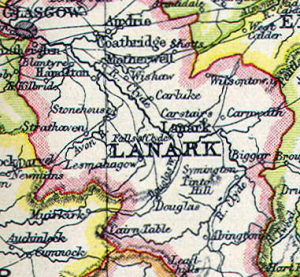 1567 Robert Montgomvery, 6th of Skelmorly, married 20 may 1567 to Dorothy or Mary Semple {Dorothea Sempill}, dau of Robert Lord Semple. [ODNBxvii1175q.v.] [FGC8-H7] ). Map with Carnwath in east central Lanark, east of the River Clyde which is flowing north and west, between Glasgow and Edinburgh.
1567 Robert Montgomvery, 6th of Skelmorly, married 20 may 1567 to Dorothy or Mary Semple {Dorothea Sempill}, dau of Robert Lord Semple. [ODNBxvii1175q.v.] [FGC8-H7] ). Map with Carnwath in east central Lanark, east of the River Clyde which is flowing north and west, between Glasgow and Edinburgh.
![]() 1579 William Ruthven thanked for the discharge of his commission against Hamiltons. Hamilton
1579 William Ruthven thanked for the discharge of his commission against Hamiltons. Hamilton
[Hamilton 2Stewart 2Millar 2simmons 2Choate 2Sorensen]
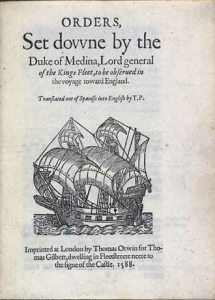 1588 The Spanish Armada set sail from Lisbon. The execution of the Catholic Mary Queen of Scots in 1587 was the final spur for the Spanish invasion of England. Too little, too late. The title page a contemporary English translation of Medina Sidonia’s
orders for the Armada. The illustration is of a Portuguese galleon of the Armada. The Armada will circle around Scotland (circumnavigate British isles) .
1588 The Spanish Armada set sail from Lisbon. The execution of the Catholic Mary Queen of Scots in 1587 was the final spur for the Spanish invasion of England. Too little, too late. The title page a contemporary English translation of Medina Sidonia’s
orders for the Armada. The illustration is of a Portuguese galleon of the Armada. The Armada will circle around Scotland (circumnavigate British isles) .
May 20 1602 Edinburgh was free of plague on May 1, and solemn thanksgiving held. A History of Epidemics in Britain from A.D. 664 to the Extinction of Plague Charles Creighton, M.A. M.D. Demonstrator of Anatomy University of Cambridge. 1891
1631 Sack of Magdeburg, by imperial troops, which began on May 20, and in Which a major portion of the population was murdered and the city burned.
when Gustavus Adolph and his force of 13,000 landed at Peenemünde in 1630, the Imperial Commander of the German Catholic League, Tilly, did not immediately respond, being engaged in what seemed to be more pressing matters in northern Italy. Gustav’s sole ally was the city of Stralsund, and over the ensuing months, the situation did not improve. While he could claim the support from German princes, these were the “dispossessed” like Mecklenburg and Saxe-Weimar, the expectant like the claimants to Brunswick-Lüneburg, the occupied, like Magdeburg, and the threatened, like Hesse-Kassel. The broadsides and pamphlets distributed throughout Europe assured that prince and pauper alike understood how the Emperor, or at least his troops, treated the Protestant subjects. Over the next few months, Gustav consolidated his bridgehead and expanded across northern Germany, attracting support from German princes but mostly building his army from mercenary forces along the way Scots mercenaries, Colonels Hugh and Bryce Cochrane in service of Gustavus. Hugh, ancestor of the Cochranes of Fernguflee, alfo a great loyalist, who first fervid in the wars abroad under the great general Guftavus Adolphus, was afterwards a colonel in king Charles I, his army, and was particularly excepted from pardon by the parliament, anno 1648
1732 – Thomas Boston, Scottish church leader (b. 1676).
1750 – [Robert Miller III]’This Sermon Delivered in St. John’s, Charles Town, South Carolina, the 20th of May 1750.’manuscript sermons, yellowed but still entirely legible, in the possession of Col. Francis Pickens Miller in 1970, was delivered before leaving Scotland. 83 YYMA (descended from clans Stewart, Hunter, Lockhart, Meldrum, Cochrane)
1776 – Simon Fraser, Canadian explorer (d.1862). Son of Isabella Grant and Simon Fraser, both of whom had immigrated from Scotland in 1773.
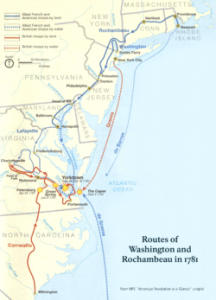 1781 On May 20, Charles Cornwallis arrived at Petersburg with 1,500 men after suffering heavy casualties at the Battle of Guilford Courthouse, joining the army of Phillips, who had recently died of a fever. Cornwallis had not received permission to abandon the Carolinas from his superior, Henry Clinton, but he believed that Virginia would be easier to conquer, feeling that it favored an invading army. National Park Service map of the W3R Route
1781 On May 20, Charles Cornwallis arrived at Petersburg with 1,500 men after suffering heavy casualties at the Battle of Guilford Courthouse, joining the army of Phillips, who had recently died of a fever. Cornwallis had not received permission to abandon the Carolinas from his superior, Henry Clinton, but he believed that Virginia would be easier to conquer, feeling that it favored an invading army. National Park Service map of the W3R Route
 1908 James Maitland “Jimmy” Stewart born. Died July 2, 1997. Brigadier General. American actor. Scottish descent, Presbyterians. Princeton. Son of Elizabeth Ruth (née Jackson) and Alexander Maitland Stewart, United States Air Force, 1959. 445th Bombardment Group, 453rd Bombardment Group, Eighth Air Force, Strategic Air Command. World War II, Vietnam War. Stewart donated his papers, films, and other records to Brigham Young University’s Harold B. Lee Library in 1983. Wikipedia
1908 James Maitland “Jimmy” Stewart born. Died July 2, 1997. Brigadier General. American actor. Scottish descent, Presbyterians. Princeton. Son of Elizabeth Ruth (née Jackson) and Alexander Maitland Stewart, United States Air Force, 1959. 445th Bombardment Group, 453rd Bombardment Group, Eighth Air Force, Strategic Air Command. World War II, Vietnam War. Stewart donated his papers, films, and other records to Brigham Young University’s Harold B. Lee Library in 1983. Wikipedia
1920 – John Cruickshank, Scottish airman, Victoria Cross recipient.
1920 also sometime this year. Hortense McDuck married Quackmore Duck. They are the parents of Donald Duck. (fictional clan McDuck)
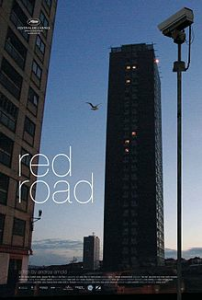 2006 Red Road released Cannes. British film directed by Andrea Arnold. A CCTV security operator who observes through her monitors a man from her past. It is named after, and partly set at, the Red Road flats in Barmulloch, Glasgow, Scotland which were the tallest residential buildings in Europe at the time they were built. Wikipedia. Poster. Tartan Films (USA)
2006 Red Road released Cannes. British film directed by Andrea Arnold. A CCTV security operator who observes through her monitors a man from her past. It is named after, and partly set at, the Red Road flats in Barmulloch, Glasgow, Scotland which were the tallest residential buildings in Europe at the time they were built. Wikipedia. Poster. Tartan Films (USA)
2016 Utah is ranked 2nd highest (4.6% of the state population) among the 50 United States with the top percentages of Scottish residents (Wikipedia 26 March 2017 https://en.wikipedia.org/wiki/Scottish_Americans#Scottish_Americans_by_state ). How are the Scots in Utah doing?
Wall Street 24/7 ranked Utah the number one state in the nation for business in 2016.
http://www.onlyinyourstate.com/utah/ut-is-number-one/
Disclaimer: The author of each article published on this web site owns his or her own words. The opinions, beliefs and viewpoints expressed by the various authors and forum participants on this site do not necessarily reflect the opinions, beliefs and viewpoints of Utah Standard News or official policies of the USN and may actually reflect positions that USN actively opposes. John Choate © No claim in public domain or fair use.
Utah Standard News depends on the support of readers like you.
Good Journalism requires time, expertise, passion and money. We know you appreciate the coverage here. Please help us to continue as an alternative news website by becoming a subscriber or making a donation. To learn more about our subscription options or make a donation, click here.
To Advertise on UtahStandardNews.com, please contact us at: ed@utahstandardnews.com.



Comments - No Responses to “May 20th Scots Book of Days Eliza Doolittle Day”
Sure is empty down here...